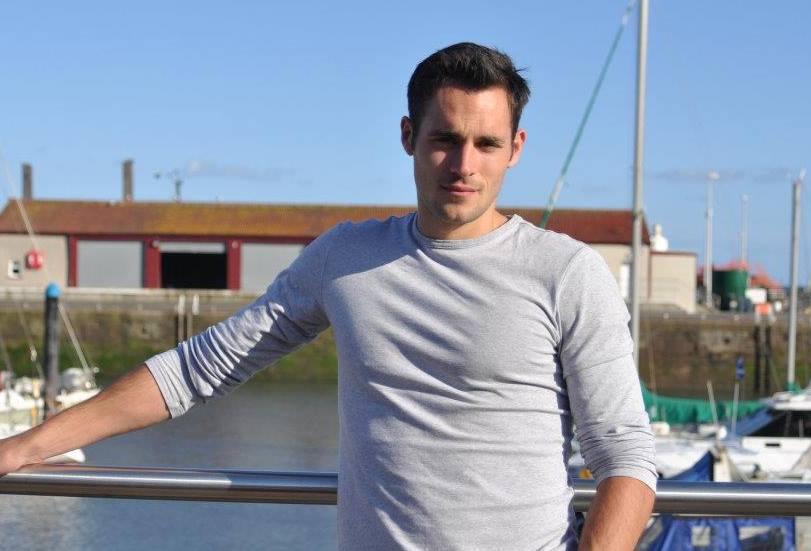
My name is Kevin Cumming. I work for a charity called the Langholm Initiative (LI) based in the town of Langholm in Dumfries and Galloway in Scotland. I hold a BA (hons) in Business Administration and an MSc in Conservation and Management of Protected Areas. Currently I manage the LI’s Wild Eskdale project which aims to provide outdoor education for the local community whilst promoting eco-tourism in the area.
Imagine a place where hen harriers roam above the dramatic hills of a former grouse moor, sky dancing alongside the unmistakeable call of the curlew. Flowing through this moor might be a river with a hidden world beneath its surface, home to playful otters and bobbing dippers. Native woodlands thriving and creating a mosaic of wonderful habitats. Now consider the benefits if such a place could be protected and taken into community ownership by the people who live and work there. No need to stretch your imagination too far because Langholm Moor in the South of Scotland is such a place, and a unique opportunity has arisen for this precious land to be taken into the care and ownership of the local population through a community buyout.
Make no mistake, this is a big landscape scale project pushing the boundaries of community regeneration and ecological restoration.
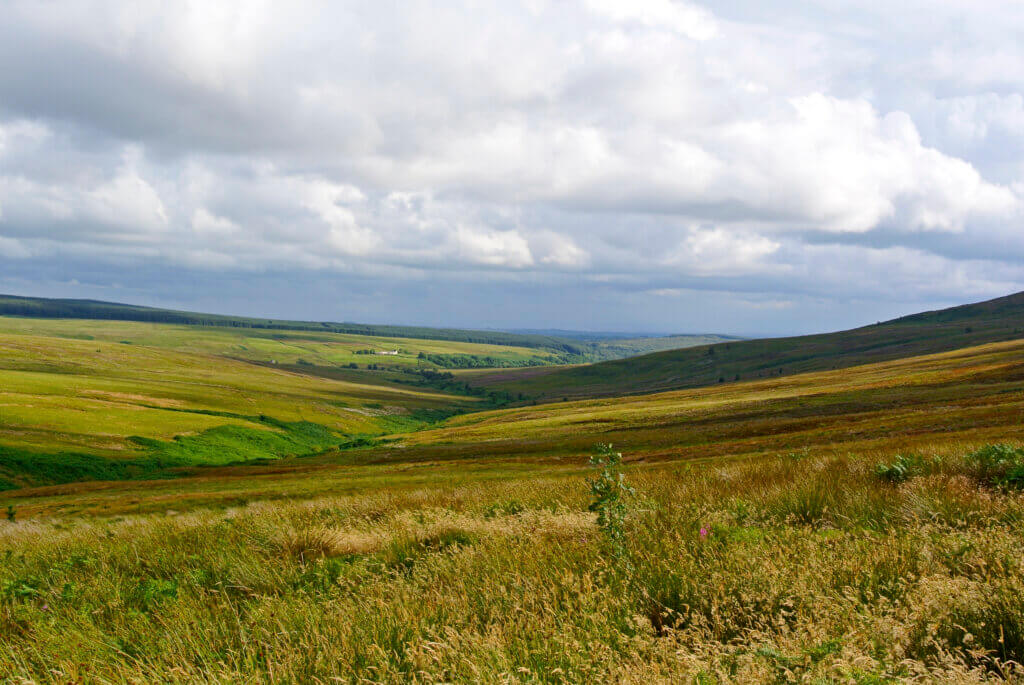
So here it is, my take on one of the most important community projects in the UK…
The Langholm Moor Community Buyout
The Sky Dancers have returned, the winter’s rain has eased and in the South of Scotland the community of Langholm are preparing for one of the most ambitious plans of a generation.
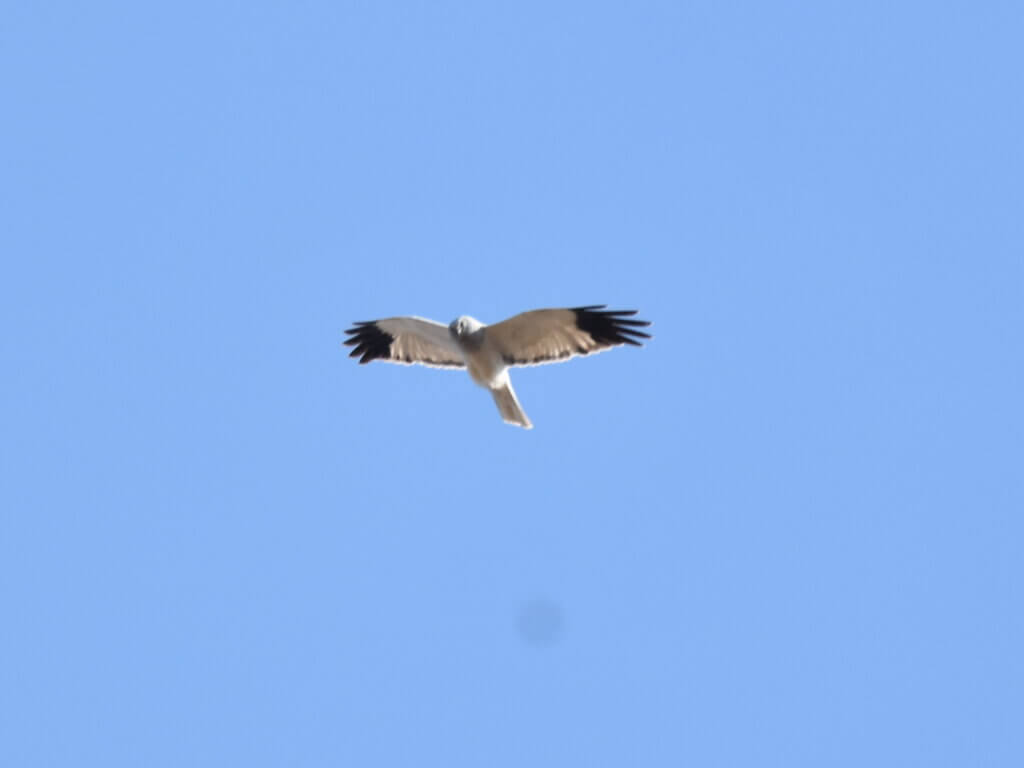
For the past eight months I have been leading a local working group to investigate the potential for community ownership of nearly 10,500 acres (about 5,600 football pitches) of land close to the town for positive climate action, community regeneration, ecological restoration and wildlife conservation.
During this eight month period unprecedented events occurred in both my own life and around the world. For me personally my first child Freya was born. However, in her first few months of life, we have seen the devastation caused by the Australian wildfires and of course the global impact of Covid-19. In these difficult times this community buyout at Langholm is important because it is a project of vision, it is a project of hope when we need it the most, and perhaps above all, it is a project for our future.
The robust plans put together by the community of Langholm place the environment and climate action at the heart of their decision making. Today we launch our Langholm Moor Crowdfunder and with your help we will be able to make this vision a reality.
The significance of this project cannot be overstated. It addresses so many of the questions we face not only here in the UK but around the world. The climate emergency is the biggest long-term threat that humanity faces. Tackling this threat is going to take landscape scale change to reverse the decades of mistreatment of our natural world. By taking Langholm Moor under local community ownership we want to demonstrate that individuals coming together for a common purpose can do something truly amazing.
We are delighted to say that today the John Muir Trust have demonstrated their faith in the project by announcing that they will be kick-starting the fundraising effort by pledging £100,000 towards the purchase.
Why Langholm?
Langholm was once a booming centre for the textile industry. Most local people would finish school and instantly find local employment in the mills. Speak to people here and they will tell you of the days when you could walk out of a job in the morning and walk into another by the afternoon.
Sadly these days have gone and over the last 20 years there has been a rapid decline in the industry. Just three weeks ago the last mill in Langholm announced its likely closure.
Langholm now faces the same problems as many other rural areas in Scotland; loss of industry, youth migration and an aging population.
Something has to be done to change the fortunes of this once thriving community.
Why This Land and Why Now?
Langholm Moor has huge cultural and natural heritage. People here are immensely passionate about the land they believe to be theirs and have marked the boundaries of the common land for over 250 years. This tradition still goes on today with a spectacular annual event, the Langholm Common Riding.
The national and international importance of the natural heritage on this land is recognised by large parts of it being designated as a Site of Special Scientific Interest and a Special Protection Area (for Hen Harriers).
Many of you may be familiar with Langholm Moor: it has been the site of two scientific studies regarding land management for the purpose of driven grouse shooting. The latest of these studies, the Langholm Moor Demonstration Project (LMDP), produced its final report last year (LMDP Final Report). The key finding of this project was clear that driven grouse shooting was no longer economically sustainable on Langholm Moor.
After the conclusion of this study the current landowner announced their decision to sell the land and hoped to do so quite quickly. If the people of Langholm were to have a say in how their moor would be managed they would have to act promptly. The clock started ticking and the question that faced us was “what could you do with a former grouse moor?”
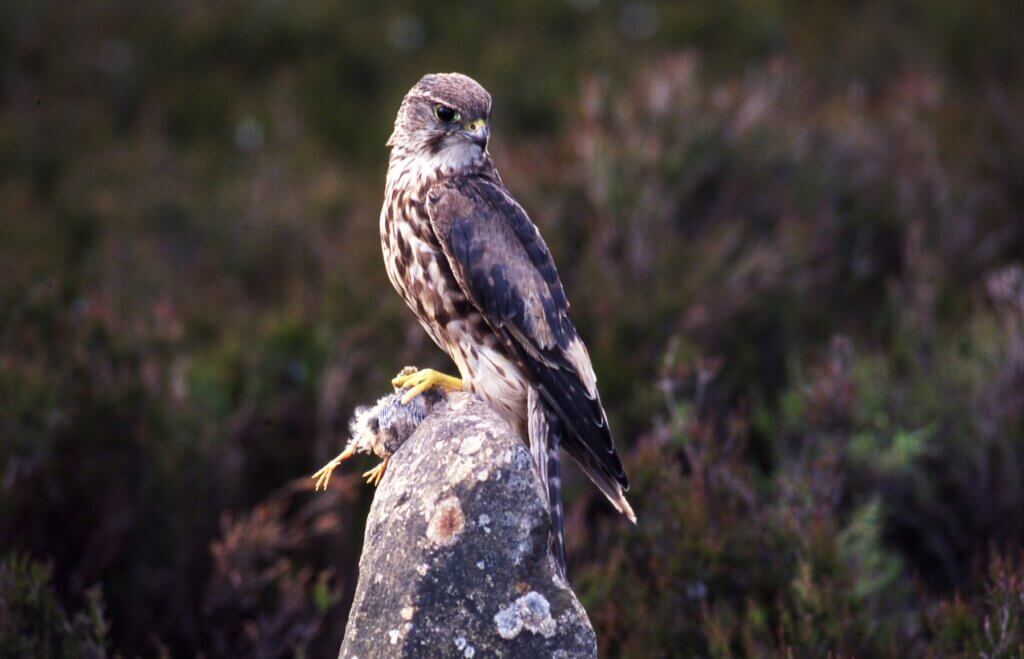
What will the community do with the land?
The project we have developed over the past eight months in close consultation with the community covers a wide range of subjects. Broadly speaking I would say that it is a project to improve our future both environmentally and economically.
The Langholm Initiative are proposing that we undertake climate action, wildlife conservation, ecological restoration and community regeneration all built around a central goal – creating the Tarras Valley Nature Reserve
On this land, we will carry out work such as peatland restoration, new native woodland creation, ancient woodland regeneration and protect and enhance the incredible flora and fauna that lives here. Repairing damage to our internationally important peatlands will improve carbon storage. Five hundred acres of new native woodlands will provide fantastic new habitat, offer amenity use and sequester carbon dioxide from the atmosphere. Ancient woodland regeneration along the Tarras Water will help provide a mosaic of habitats across the land.
We will investigate sustainable and responsible outdoor tourism. I have travelled all over Scotland wildlife watching and can honestly say that the experiences of Langholm Moor are unique and spectacular.
In a single day I can be treated to the spectacular sky dancing of courting hen harriers, witness the silent hunt of a short-eared owl or be mesmerised by the intimate lekking of black grouse. I can be thrilled by the chase of merlin hunting a meadow pipit, I can smile as I enjoy newly fledged dippers come to terms with life on the Tarras Water and I can laugh at the antics of the wild goat kids. This is a special place – a hidden gem in the South of Scotland.
Is the project sustainable?
At the beginning of this project we were able to raise enough money to undertake some very intensive investigations into the viability of community ownership. Many people donated to our first crowdfunder to help with this (thank you!)
Our feasibility study found that community ownership can be financially viable, and it can run into a modest surplus right away. The main sources of revenue come from an existing commercial forestry plantation, rent from leased residential properties, agriculture and other tenancies. A summary of the Feasibility Study and Business Plan can be found on the Langholm Initiative Website.
By including a small area of land south of Langholm Moor and close to the town of Langholm we have given ourselves options to undertake some sustainable development. This includes the potential for appropriate small scale renewable energy (a single small turbine and a single small solar farm) and the development of a small eco-campsite. We will also investigate repurposing disused and dilapidated steadings for either small scale housing or modern business units, both of which are badly needed in Langholm (there have only been 6 new houses in Langholm in the past 30 years). The vast majority of the land will be used to create the Tarras Valley Nature Reserve. However, these developments in the long term will allow us to continue to promote positive climate action while simultaneously acting as a catalyst for rural community regeneration.
Conservation and development are often seen as opposing forces because in many places, development has been carried out at the expense of the natural environment. If we continue exploiting our planet then it will no longer be able to sustain us. This is one of the main reasons why our project is so important: we will demonstrate that it is possible to deliver ecological restoration alongside the regeneration of a community.
What is the wider impact of the project?
One of the most exciting elements of this project and one that has attracted widespread support, is the potential blueprint that it could provide for other communities across the UK to improve their local environments in a post Covid-19 world.
In the long term this project could also indirectly address other topical land use issues in the UK, including alternative uses for driven grouse moors, agriculture in a post-Brexit Britain and the balance of land ownership in Scotland.
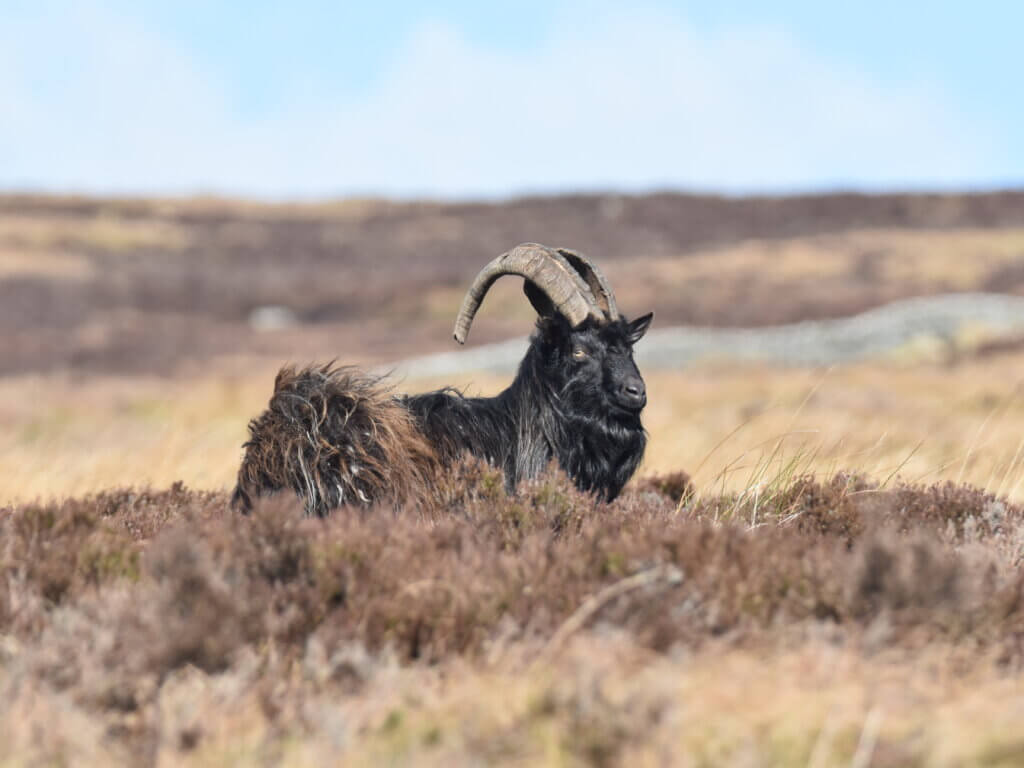
Fundraising
After a careful joint valuation process we know the total cost of purchasing the land is just over £6m. We have applied to the Scottish Land Fund for £3m and hope to raise an additional £3.4m.
The Langholm Initiative are continuing to investigate a number of funding options which we hope will help us towards this figure including the new South of Scotland Enterprise Agency.
We know this is a big ask, especially in these unprecedented and difficult times. However, if you are able to donate what you can to the crowdfunding campaign, you will not only be contributing to one of the most forward thinking community plans of a generation, you will be providing hope for a better future for everyone.
We want this project to inspire communities around the globe to strive for a brighter tomorrow. If you can help us reach our goal, we’ll be another step closer.
[registration_form]
a thoroughly wonderful aspiration we should all support. However given that much of this land, if not all of it, was “taken” (really stolen, with the connivance of government) by Buccleuch during the enclosure thefts from the ordinary folk who depended on it for their agriculture and livelihoods the estate should be giving it to the community.
My one concern is goats these are not wild they are feral, the only truly wild goats in Europe are Ibex. Its one of the things on the execrable “Countryfile” that winds me up, talk of wild ponies and goats, even as they round them up for the owners. They are not wild! For me these feral non -natives would be removed to protect trees and vegetation.
There was also a problem when they wanted to remove the feral goats at Carrifran to enable ecological restoration, there was a bit of a kick off about them being part of the ‘natural heritage’. Thankfully those looking at the bigger picture won and Carrifran is now a cracking example of what can be done which is a lot more exciting than some goats that happened to have been overgrazing that valley for far too long. The RSPB have also had a bad time at Inversnaid, the ancient woodland and its fantastic native fauna and flora was being hammered by goats again. However, the locals were blind to this and claimed the goats were a big draw for tourists (which I’m sure will be news for many) and I believe the RSPB has had to resort to a form of goat birth control to save the real wildlife while keeping the locals happy. Sometimes locals need a kick up the arse. We definitely need more public education which we’re not going to get from the likes of Countryfile.
About the only good thing you can say about feral goats is when they die they are good eagle and raven food. Plus when shot they are marvellous eating, I’ve never understood the British lack of a tradition of eating goat. We used to have goats or a goat for milk and ate the kids at about a year old, its a wonderful meat. Despite claims that feral goats have been in places for hundreds of years, many in Scotland would have been domestic milk providers before the clearances and left behind when folk were forced off the land.
I find it hard to beat a good goat curry!
Ponies can be a very good for conservation grazing
Indeed, but let’s not pretend they (or goats) are wild
I lived in Langholm as a youngster and can remember walking up to the monument on numerous occasions. I always enjoyed those walks even trudging through the heather. The only reason Buccleugh is selling up is Grouse numbers have been so low the past few years and all these goody goody 2shoes who thing a blanket of trees and reintroduce wild animal and probably sea eagles as well are the only solution.
Years ago we supported the islanders on Eigg for a Community buyout. This is another project well worth the investment. Good luck, looks like a good start.
We have just donated for this wonderful project. We look forward to visiting the site the next time we are in Scotland.
This is tremendously exciting not just on account of it being a change for a former grouse moor, but it’s in the south of Scotland which although it tends to be overshadowed by what’s north of the central belt actually represents one hell of a lot of land with perhaps even more scope for ecological restoration – an even blanker slate to start with. It’s overlooked far too often so this is great Kevin, a lot of hard work behind and in front of you, but what a fantastic opportunity to do something with real potential to help people and wildlife.
The guiding principles of this effort are to be wholly commended, but has anyone really scrutinised the amount you are being asked to pay for it? I can’t see on what basis it could be valued at such a figure. I mean, what are the options for it? Grouse, Forestry, Sheep, Windfarms? None of the Sporting Agents will want to touch it (Leadhills style) with a barge-pole due to the scrutiny and recent controversial history. But by paying such an inflated high price are you not letting Buccleuch laugh all the way to the bank? and lining their pockets which will inevitably pour money back into the driven grouse industry somewhere else ? Truly sorry to sound negative, I know hearts are in the right place…and I just hope that I am missing something, which I probably am!
Thanks for the comment and this is an important point. The valuation was a joint process which has taken several months.
For a community buy out application to the Scottish Land Fund (where we have applied for £3m) we require a red book valuation by a RICS qualified surveyer.
A large part of the 10,500 acres of the land is as you say relatively low value. However as this project is looking at a new model of financing climate action and ecological restoration as well as community regeneration there are higher value elements which provide revenue. It is vital this is a financially viable project.
The higher value parts of the purchase are: 9 residential properties and associated outbuildings, an exisinting commercial forestry plantation and land that could have commercial plantation on it if thats what a buyer wanted to do (we dont).
These higher valued areas are closest to the town and provide most of the revenue for running the land.
Many thanks again for the comment.
Thanks for the reply Kevin. I know quite a bit about the economics of land use in the uplands – and it just struck me as very high considering the commercial grouse side can be almost completely discounted. I openly admit I have no knowledge about the value and potential of the buildings you refer to. As well as being morose, I am also cynical and sceptical especially when it seems that one of the “great” aristocratic estates is going to do something to help anybody but themselves. But as I said earlier – I agree completely with the principle of your ideas and do want you all to achieve what you hope for. The nightmare scenario of some greedy agent “with a ten year plan” and a crack team of keepers/slaughter-men waiting to resurrect the grouse side is just unthinkable. Good luck!
Sphagnum – I’m not sure why commercial grouse shooting can be discounted. The July Red Grouse numbers towards the end of the second Langholm project were higher than they were before the first Langholm project when commercial grouse shooting was sill taking place. Well, I don’t know how commercial or profitable it was but there were lots of grouse being shot. In fact a large part of the first Langholm project was based on the fact that Langholm was a viable grouse moor going in to Langholm 1. So, the fact that there were just as many Red Grouse available to shoot coming out of Langholm 2, and a bunch of Hen Harriers flying around the moors too, suggests that the moor would have commercial value. And on the open market that value would have to be taken into account.
It doesn’t appear that the grouse shooting industry has been gagging to take on this moor though, maybe increasing Red Grouse bags and wiping out Hen Harriers on the moor would be too blatant a move even for this shameless industry. The fact that Buccleuch hasn’t sought to revert to driven grouse shooting and that no driven grouse shooting interests are agitating to take the moor back into shooting use says a lot for how far we have come towards ending this thoroughly flawed land use.
Of course, that might change were this crowdfunder to fail in its aim.
Thanks Mark, you are probably right – as you say they are so brazen and shameless…and greedy…that I might be overconfident in thinking that nobody would dare “do a Leadhills” ie try and imprint the model of the english / pennine grouse moors onto Langholm. After all the fundamental potential for intense DGS still remains there. It would just need about 7-10 years of investment and a lot of killing. But without any reliable intelligence from within the world of the go-to Agent and grouse consultant types (and I have none), we are all in the dark. We could not be sure whether that risk is real or a devious bluff just to inflate the price for Buccleuch. It may be best to not take the chance, to support it and to contribute to the crowdfund (I am about to do so myself) and give the venture every chance of success.
More than happy to support this project. Only twenty five miles as the HH flies to Carrifran (a lot further for us mortals), with only the tiny village of Eskdalemuir breaking the monotony of bare and largely lifeless hills. Wouldn’t it be a wonderful vision for the future to see the two areas joined up for the benefit of all. Could show that lot on the other side of the A7 what real woodland and wilder moors should really look like.
We might even be tempted to tarry a wee while longer in the area rather than just a stop on the way to our beloved west coast.
I do have to agree with Spaghnum above though, it does sound an awful lot of money for land that was stolen anyway. As Stuart Mackay said yesterday on RPUK, the government should really be buying this land back off the present owners and returning it to the rightful ones.
Anyway, all the best for this crowdfunder. Will watch with great interest.
Will the sporting rights be transferred, in full , to whoever purchases the land ?.
Yes
I want this to succeed, but my big concern is how are you going to finance this in the present circumstances. I assume everyone involved will be salaried and PAYE pensioned? Reliance on grants and handouts to pave your future is not the logical business answer. What you don’t have is a membership to yearly supply you with income. Let’s be under no illusion here you are creating a business, all be it a Trust, the rules of business acumen still applies to you.
I like the idea of residential properties, to me that makes a lot of sense, maybe you can raise up to £100,000 + per year if marketed correctly, but depending what condition they are in now, you still have to finance the conversation, and the ongoing legal side of tenancy. I doubt hundred grand is going to cover your business costs for an enterprise such as this.
You and I agree on the commercial plantation, there is nothing more destructive in conservation than the planting of mass trees for commercial usage. Far from being a green option, the process of planting, felling and transportation is about environmental friendly as the Torrey Canyon.
Covid-19 has one last twist of the knife for every one of us – the invoice. It will change our whole lives dramatically and that includes individuals, businesses and charities. We have already had the CEOs of the charities bemoaning they don’t have enough money, when in fact they are all asset rich.
Every charity has a common denominator flaw; they see each other as competition, – rivals for those lucrative grants. That for me has been a huge eye-opener, where I would think of working together to achieve a common goal, they don’t, not where there’s a payday is at stake.
You are about to enter this bear-pit too, competing not only with the big boys, but the hundreds of other charities, all-vying for the same financial windfall. Covid-19 is about to blow some of these charities out the water.
The grouse moor landowners own the land not because it’ll make them oodles of money; it doesn’t, whether old or new money, they are financially independent of the grouse-shooting season activities. The grouse are the reason why these moors exist. The minimum you need to do is replicate the income stream that grouse shooting provides.
And how much economic benefit do grouse moors bring in really Thomas? Even in years in which the shooting isn’t cancelled because of ‘low’ grouse numbers do you really think the local community benefits much from it, even IF the estates don’t ferry in beaters from other areas, even IF they consciously do everything possible to source all their supplies locally (as the RSPB has always done), rather than ship in goods from the fancy London shops for their ‘elite’ clientele? I wonder how rural communities in Scandinavia, Russia and North America manage without creating vast moors so willow grouse can be driven and shot. Maybe they somehow get along with more traditional hunting, fishing and shooting, woodlot forestry and recreational pursuits that don’t knacker the land and are open to the vast majority of the population rather than an absolutely minute minority.
The economics of flood avoidance needs to be factored in too, what value of targeted tree planting and beaver translocation along with peatbog restoration and cessation of muirburn? Well the 2005 Carlisle flood cost 400 million quid plus, and some of its watershed is actually in Scotland. They’ve been pedalling rather condescending scare stories for years that ‘poor’ little communities just can’t manage without the patronage of those lovely owners paying out of their own pockets and goodness of their hearts. The idea that people like Kevin can’t do a better job than those whose only interest was rotationally incinerating the hills and slaughtering their wildlife to facilitate glorified clay pigeon shooting is ludicrous.
Thomas – why is it necessary to ‘replicate the income stream that grouse shooting provides’?
Hi Thomas, you raise good points there and ones we have had to consider during our 6 months of investigations. I will direct you to http://www.langholminitiative.org.uk for a summary of the business plan which should help answer a number of your points.
Here I will let you know the process undergone to demonstrate that we have taken the points you have raised seriously throughout the process.
To apply to the Scottish Land Fund you are required to present a strong arguement for the purchase. To do this we secured funding to undertake robust investigations into communtiy ownership. We agreed that if it would not be financially viable we would not pursue it.
We appointed a very strong team to undertake this work including:
A core team of 3: Communtiy development specialist, an accountant and a foresty specialist.
Valuers for the community: Davidson and Robertson (team of 4)
Investigation into small scale renewable energy projects which compliment the overall goals of the project: Greencat Renewables (Team of 4). The summary of this study is also on the website
This was overseen by myself and a steering group of local poeple with a range of skills and backgrounds.
The Langholm Initiative is an award winning communtiy development trust which was formed in 1994 and has been delivering community projects since then.
Thanks again for the comment.
A lovely dream that will have the spongers flocking to get their feet under the table and snouts in the trough! And if enough money is not raised will it be given back or lost in accounting? Should the project go ahead will wolves be introduced to control the goats? Goat curry so unvegan! The yurt dwelling dreadlock crowd much prefer GM maize products imported from China!
The Harriers will eat what grouse are left, Beavers block rivers and with help of the otters destroy any wild trout, crayfish water rats etc, woods to be planted to harbour crows foxes buzzards etc and once all the prey has been consumed they will all be looking to neighbouring moors and estates for food!
Good luck!
‘Me thinks the lady doth protest too much…’ Thank you for a great laugh first thing in the morning Will, I take it you’re one of those dear folk who take it upon yourself to be guardians of our countryside? That would explain why it’s in such a mess – not producing much employment, wildlife poor and flood and fire prone too. Your number’s up I’m afraid, well actually I’m very pleased it is, it’s been long overdue. I have stayed in a yurt (and a brown bear might have bumped into its side one night), but I don’t have dreadlocks. Have you stayed in a yurt Will, is your objection to them based on personal experience or would that be outside of your clearly narrow comfort zone? Do you think people having a bit of an adventure by staying in a yurt is not legitimate, but slaughtering driven grouse is?
I feel I need to correct some of your comments re wildlife as like many of the fieldsports enthusiasts, of which I suspect you are one, you haven’t had that much experience with it. I have friends with beavers on their property and surveys including the use of electro fishing have shown trout are growing bigger in beaver pools. That’s helping the local otters too which need a food supply and like all other animals can’t afford to kill it off. They’ve found in Devon that the structural complexity beavers create with their woodworking has increased water vole (they’re not rats Will) numbers even in the presence of American mink. Why would anyone of sound mind think that beavers are bad for water vole!?! And at RSPB Insh Mashes beavers there would almost certainly help waders and other ground nesting birds by keeping the scrub back something that has to be done with volunteers at present.
As far as snouts in troughs goes Will, well that’s the territory of those that’ve been getting ‘agricultural’ subsidies for grouse moors and god knows what else for donkey’s years. I also suspect that some of the money spent on grouse moors from the owners or clients isn’t particularly clean either.
…//../ ‘;’;;’//,, oh, sorry I think I touched the keyboard while nodding off to your recital…louder next time please…